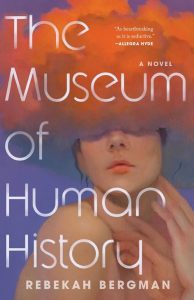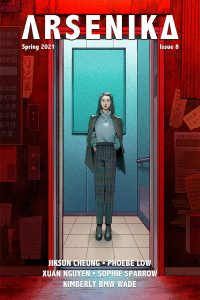Jake Casella Brookins Reviews The Museum of Human History by Rebekah Bergman
 The Museum of Human History, Rebekah Bergman (Tin House 978-1-95353-491-0, $17.95, 256pp, tp) August 2023. Cover by Beth Steidle & Yang Cao.
The Museum of Human History, Rebekah Bergman (Tin House 978-1-95353-491-0, $17.95, 256pp, tp) August 2023. Cover by Beth Steidle & Yang Cao.
Told in chapters that jump between disparate characters and across years, Rebekah Bergman’s The Museum of Human History is very loosely centered on twin sisters, Evangeline and Maeve Wilhelm. Following an initially unexplained accident, Maeve falls into an uninterrupted and ageless sleep. As the narrative loops around this mystery – each chapter titled by its chronological relationship to Maeve’s slumber – we learn more about the twins’ family and community, the town of Marks Island, the titular museum, and the scientists and pharmaceutical company pursuing a cure for aging. Science-fictional and even magical in some of its conceits, the novel is grounded in human detail, with a pensive, compassionate fixation on loss.
Tonally, thematically, the novel pairs quite nicely with works such as Jesse Ball’s A Cure for Suicide or Yōko Ogawa’s The Memory Police. The Museum of Human History also takes place in a carefully stripped-down, abstracted world, which heightens the sense of melancholic surrealism. It’s surreal not in the sense of outlandish or strange, but in that it reads as a series of emotionally resonant images and scenes, symbolic and flowing somehow naturally into each other, even though, on stepping away, they’re clearly operating on their own logic. ‘‘Folkloric’’ or ‘‘mythic’’ might be a better descriptor, despite the mundanity of its subjects. It’s not exactly a retelling (thank goodness), but the novel draws heavily on ‘‘Sleeping Beauty’’, though it departs from that frame for long stretches; there’s echoes of ‘‘The Pied Piper of Hamelin’’, as well, in how the novel circles the loss of youth and youths.
Not to say the novel feels internally disconnected. It is a deeply self-referential book – enclosed, almost, an assemblage, with almost every character and event, however seemingly minor, winding often-unwittingly through every other storyline. The twins’ babysitter becomes the celebrity artist making statements about the anti-aging treatment – itself developed by the twins’ mother, advertised by another character who also takes the treatment, whose dying wife has several anonymous but indelible interactions with the twice-bereft Evangeline; and it turns out the babysitter-turned-celebrity is originally a refugee from the island where the pharmaceutical company ran their first set of unethical experiments.
Although this might sound complicated, in practice it’s a deft composition, with each scene emotionally self-contained, tiny details cross-linking to other storylines, and basically no loose threads. It’s a cat’s cradle, and indeed it’s a karass – though there’s little here of Vonnegut’s flippancy or wordplay, The Museum of Human History has a kind of tragic humanism, and a sense that things are fated, perhaps beyond human meanings, that calls his works to mind. It’s an impression only strengthened by the time-jumping narration, which skips continually back and forth over several decades, always in reference to Maeve’s enchanted sleep. Seemingly random at first, the narrative shifts are not a way to inject suspense or maintain the novel’s mysteries, but instead do a fascinating job of revealing Bergman’s interests here: not a plot, not a series of events, but a shape, a set of central concerns that manifest differently for different characters at different times. Another writer might have centered the mysteries of Marks Island – the mechanics of the anti-aging treatment, the red rocks and marine flora woven throughout, the secrets of the prehistoric humans the museum honors – but Bergman instead infuses them with a pathetic transparency: questions that seem monumental (to one character, at one time) appear trivial when one can step back and consider the whole.
One of the most fascinating bits of reading this book – and I should be clear that this may be more about my reading than the book itself – is how strongly it left me thinking about literature and climate change. Global warming feels almost inescapable in fiction right now: future-set science fiction must deal with it, even if that’s only by a glib reference to carbon capture or drowned cities, and the number of writers writing ‘‘cli-fi,’’ often from outside speculative traditions, is immense. While cli-fi can be thrilling and optimistic, techno- or otherwise, many recent works lean into solastalgia, into grief and loss; what I haven’t seen much of is the kind of grappling with species-and-culture-level mortality that informed so much SF of the nuclear anxiety era. What happens to art, to any human activity, when it’s set against – not the chance, but the certainty that it will be forgotten? Despite the fact that The Museum of Human History is not overtly dealing with today’s vision of climate change, it steadily and repeatedly engages with questions of forgetting and mortality, it invokes geological timescales in the midst of intimate human moments, and it juxtaposes an impossible wish for immortality against the loss of children and, by implication, the future. The specter of the Anthropocene constantly hovers around its pages.
This is not only, or not exactly, an ode to futility, and it tempers its melancholy with an unsentimental humanity. Indeed, there’s a sly humor at work in the novel – the parallels between the grandly titled ‘‘Museum of Human History’’ and a quite amateurish museum of insects, the ruthlessly evil Siegler pharmaceutical corporation as a jab at the Sacklers, the simultaneous pathos and slapstick of the cult that springs up around the sleeping Maeve. Bergman has a real skill at capturing flashes of childhood emotion, conflicted but genuine human connections, and the black comedy that manifests even in a terminal diagnosis or the slow decline of dementia. The Museum of Human History uses these moments to light a haunting meditation on mortality and memory.
Jake Casella Brookins is from the Pennsylvania Appalachians, and spent a fantastic amount of time in the woods. He studied biology, before switching over to philosophy & literature, at Mansfield University. He’s been a specialty coffee professional since 2006. He’s worn a lot of coffee hats. He worked in Upstate New York and Ontario for about 8 years. He’s been in Chicago since 2013; prior to the pandemic, he worked for Intelligentsia Coffee in the Loop. Starting in 2021, he’s been selling books at a local indie bookstore. He lives with his wife, Alison, and their dogs Tiptree & Jo, in Logan Square.
This review and more like it in the November 2023 issue of Locus.
 While you are here, please take a moment to support Locus with a one-time or recurring donation. We rely on reader donations to keep the magazine and site going, and would like to keep the site paywall free, but WE NEED YOUR FINANCIAL SUPPORT to continue quality coverage of the science fiction and fantasy field.
While you are here, please take a moment to support Locus with a one-time or recurring donation. We rely on reader donations to keep the magazine and site going, and would like to keep the site paywall free, but WE NEED YOUR FINANCIAL SUPPORT to continue quality coverage of the science fiction and fantasy field.
©Locus Magazine. Copyrighted material may not be republished without permission of LSFF.






